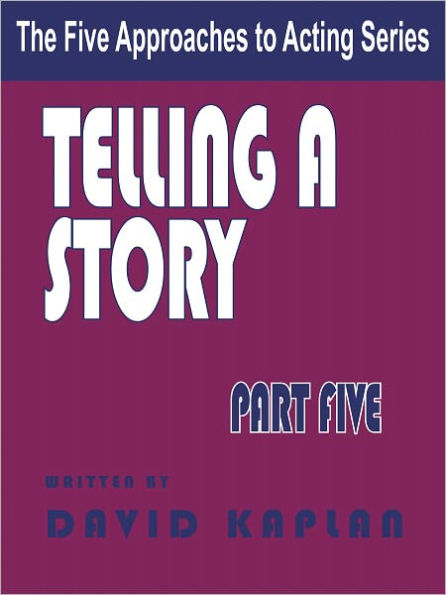Telling a Story
Telling a Story, Part Five in the Five Approaches to Acting Series is a chance to learn true witchcraft: the casting of a spell on audience members so that they see what isn’t there. More, the telling of a tale can reveal the occult: what takes place in the mind of the speaker. Shakespeare’s soliloquies offer an actor special opportunities to reveal the processes of thought, and there is a separate chapter in Telling a Story, Part Five in the Five Approaches to Acting Series about ways to prepare and perform soliloquies from Shakespeare’s plays. Like Mae West’s sultry recitation of nursery rhymes, Romeo’s bashful recitation of Juliet’s charms works from the principle that it’s not what you say, it’s how you say it — and what happens to you while you say it. Actors burdened with “emotional memory” in story-telling are given access to a more useful technique by identifying point of views and creating dramatic onstage action while telling a story by shifting points of view.
Telling a Story, Part Five in the Five Approaches to Acting Series offers practical techniques for analyzing texts and performing stories within the context of a play, whether written by Sam Shepard, Tennessee Williams, the ancient Greeks, or Shakespeare. Telling a Story suggests strategies for actors to switch between performance and story-telling in their approach to any role.
1030460791
Telling a Story, Part Five in the Five Approaches to Acting Series offers practical techniques for analyzing texts and performing stories within the context of a play, whether written by Sam Shepard, Tennessee Williams, the ancient Greeks, or Shakespeare. Telling a Story suggests strategies for actors to switch between performance and story-telling in their approach to any role.
Telling a Story
Telling a Story, Part Five in the Five Approaches to Acting Series is a chance to learn true witchcraft: the casting of a spell on audience members so that they see what isn’t there. More, the telling of a tale can reveal the occult: what takes place in the mind of the speaker. Shakespeare’s soliloquies offer an actor special opportunities to reveal the processes of thought, and there is a separate chapter in Telling a Story, Part Five in the Five Approaches to Acting Series about ways to prepare and perform soliloquies from Shakespeare’s plays. Like Mae West’s sultry recitation of nursery rhymes, Romeo’s bashful recitation of Juliet’s charms works from the principle that it’s not what you say, it’s how you say it — and what happens to you while you say it. Actors burdened with “emotional memory” in story-telling are given access to a more useful technique by identifying point of views and creating dramatic onstage action while telling a story by shifting points of view.
Telling a Story, Part Five in the Five Approaches to Acting Series offers practical techniques for analyzing texts and performing stories within the context of a play, whether written by Sam Shepard, Tennessee Williams, the ancient Greeks, or Shakespeare. Telling a Story suggests strategies for actors to switch between performance and story-telling in their approach to any role.
Telling a Story, Part Five in the Five Approaches to Acting Series offers practical techniques for analyzing texts and performing stories within the context of a play, whether written by Sam Shepard, Tennessee Williams, the ancient Greeks, or Shakespeare. Telling a Story suggests strategies for actors to switch between performance and story-telling in their approach to any role.
9.99
In Stock
5
1

Telling a Story
72
Telling a Story
72eBook
$9.99
Related collections and offers
9.99
In Stock

Product Details
| BN ID: | 2940013889880 |
|---|---|
| Publisher: | Hansen Publishing Group, LLC |
| Publication date: | 12/22/2011 |
| Series: | Five Approaches to Acting , #5 |
| Sold by: | Barnes & Noble |
| Format: | eBook |
| Pages: | 72 |
| File size: | 2 MB |
About the Author
From the B&N Reads Blog
